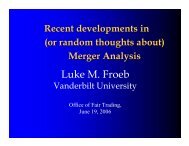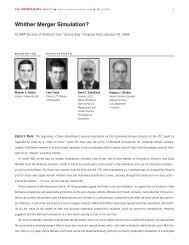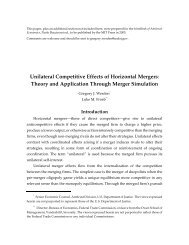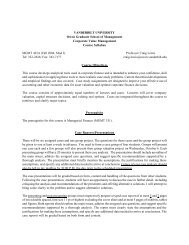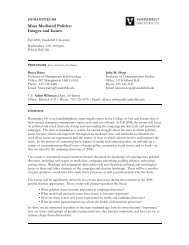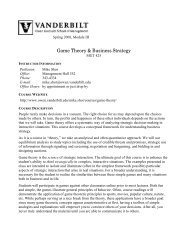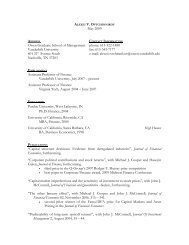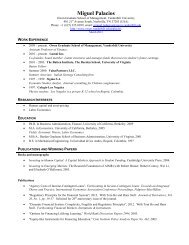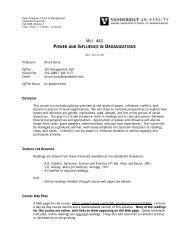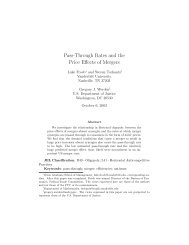the entry-inducing effects of horizontal mergers - Vanderbilt ...
the entry-inducing effects of horizontal mergers - Vanderbilt ...
the entry-inducing effects of horizontal mergers - Vanderbilt ...
Create successful ePaper yourself
Turn your PDF publications into a flip-book with our unique Google optimized e-Paper software.
THE JOURNAL OF INDUSTRIAL ECONOMICSVolume XLVI December 1998 pp. 525–43THE ENTRY-INDUCING EFFECTS OF HORIZONTALMERGERS: AN EXPLORATORY ANALYSIS *GREGORY J. WERDEN † AND LUKE M. FROEB ‡Antitrust law presumes that <strong>entry</strong> normally prevents or reversesanticompetitive <strong>effects</strong> from <strong>horizontal</strong> <strong>mergers</strong>. But when sunk costsassociated with <strong>entry</strong> are at levels suggested by prevailing market structure,<strong>the</strong> opportunity for <strong>entry</strong> created by an anticompetitive merger plausibly istoo small to induce <strong>entry</strong>, even absent Stiglerian ‘barriers to <strong>entry</strong>.’ Thisis illustrated for Cournot and Bertrand models. Significant <strong>entry</strong> alsomakes o<strong>the</strong>rwise pr<strong>of</strong>itable Bertrand <strong>mergers</strong> unpr<strong>of</strong>itable, assuming noefficiencies. Consequently, <strong>the</strong> <strong>entry</strong> issue can be collapsed into <strong>the</strong>efficiency issue: If a presumably pr<strong>of</strong>itable merger does not generatesignificant efficiencies, it cannot be expected to induce <strong>entry</strong>.I. INTRODUCTIONUS COURTS have rejected several merger challenges on <strong>the</strong> grounds thatactual or threatened <strong>entry</strong> would reverse or prevent any significantanticompetitive <strong>effects</strong>. 1 One held: ‘In <strong>the</strong> absence <strong>of</strong> significant barriers [to<strong>entry</strong>], a company probably cannot maintain supra-competitive pricing forany length <strong>of</strong> time.’ 2 Ano<strong>the</strong>r held: ‘If <strong>the</strong>re are no significant barriers to<strong>entry</strong> . . . eliminating competitors will not enable <strong>the</strong> survivors to reap amonopoly pr<strong>of</strong>it: any attempt to raise prices above <strong>the</strong> competitive level willlure into <strong>the</strong> market new competitors able and willing to <strong>of</strong>fer <strong>the</strong>ircommercial goods or personal services for less.’ 3*The views expressed herein are not purported to reflect those <strong>of</strong> <strong>the</strong> US Department<strong>of</strong> Justice. We thank Joe Farrell, Jim Langenfeld, participants in a seminar at <strong>the</strong>Antitrust Division’s Economic Analysis Group, and three referees for comments.†Authors’ Affiliation: Gregory J. Werden, Antitrust Division, US Department <strong>of</strong>Justice, Suite 10,000 Bicentennial Building, Washington, DC 20530, USAemail: gregory.werden@usdoj.gov‡Luke M. Froeb, Oweb Graduate School <strong>of</strong> Management, <strong>Vanderbilt</strong> University,Nashville, TN 37203, USAemail: luke.m.froeb@vanderbilt.edu1While <strong>the</strong> same cannot be said about o<strong>the</strong>r countries, <strong>the</strong>y all have so few decidedcases that useful international comparisons are impossible. Fragmentary evidence on ECand UK law (Finbow and Parr [1995, pp. 216–30], Fine [1993, pp. 719–21]) suggestsmany similarities to US case law.2United States v. Baker Hughes Inc., 908 F.2d 981, 987 (D.C. Cir. 1990). TheSupreme Court had previously remarked that ‘without barriers to <strong>entry</strong> into <strong>the</strong> marketit would presumably be impossible to maintain supracompetitive prices for an extendedtime.’ Cargill, Inc. v. Monfort <strong>of</strong> Colorado, Inc., 479 U.S. 104, 119–20 n.15 (1986).3United States v. Syufy Enterprises, 903 F.2d 659, 664 (9th Cir. 1990).
There are also indications that <strong>the</strong> courts do not include sunk costs as‘barriers to <strong>entry</strong>.’ Apparently following Stigler, 4 one court held: ‘Thedisadvantage <strong>of</strong> new entrants as compared to incumbents is <strong>the</strong> hallmark <strong>of</strong>an <strong>entry</strong> barrier. . . . The mere fact that <strong>entry</strong> requires a large absoluteexpenditure <strong>of</strong> funds does not constitute a ‘barrier to <strong>entry</strong>’; a new entrantis disadvantaged only to <strong>the</strong> extent that he must pay more to attract thosefunds than would an established firm.’ 5 The court added that <strong>the</strong> ‘mainsources <strong>of</strong> <strong>entry</strong> barriers are: (1) legal license; (2) control over an essentialor superior resource; (3) entrenched buyer preferences for established brandsor company reputations; and (4) capital market evaluations imposing highercapital costs on new entrants.’ 6 Ano<strong>the</strong>r court held: ‘High capitalrequirements . . . pose no barrier to <strong>entry</strong>.’ 7As suggested a decade ago by Schmalensee [1987], many courts appear topresume that <strong>entry</strong> normally will prevent or cure anticompetitive <strong>effects</strong> froma merger. 8 One district court explicitly stated that it is ‘normally a validargument’ that <strong>entry</strong> will cause <strong>the</strong> market to ‘correct itself.’ 9This paper reconsiders <strong>the</strong> role <strong>entry</strong> should play in merger cases.Following Salop’s [1991] suggestion, <strong>the</strong> analysis focuses on <strong>the</strong> effect <strong>of</strong> <strong>the</strong>merger itself on <strong>entry</strong>. By restricting output or raising prices following ananticompetitive merger, incumbents increase <strong>the</strong> amount an entrant wouldearn and create an opportunity for <strong>entry</strong>. Whe<strong>the</strong>r this opportunity leads to4The leading antitrust treatise (Areeda, Hovenkamp, and Solow [1995, p. 61]) warnsthat <strong>the</strong> definition <strong>of</strong> ‘barriers to <strong>entry</strong>’ used by many economists (e.g., Stigler) ‘does notrespond to <strong>the</strong> primary reason why antitrust law concerns itself with <strong>the</strong>m.’ Thus, it (pp.53–54) concludes that, for purposes <strong>of</strong> antitrust law: ‘A barrier to <strong>entry</strong> is any factor thatpermits firms already in <strong>the</strong> market to earn returns above <strong>the</strong> competitive level whiledeterring outsiders from entering.’5Los Angeles Land Co. v. Brunswick Corp., 6 F.3d 1422, 1428 (9th Cir. 1993). Thiscourt may have backed away from its Stiglerian position when it later held that ‘barriersto <strong>entry</strong>’ include any ‘factors in <strong>the</strong> market that deter <strong>entry</strong> while permitting incumbentfirms to earn monopoly returns.’ American Pr<strong>of</strong>essional Testing Service, Inc. v. HarcourtBrace Jovanovich Legal and Pr<strong>of</strong>essional Publications, Inc., 108 F.3d 1147, 1154 (9thCir. 1997).6Los Angeles Land Co., 6 F.3d at 1427 n.4; see also Rebel Oil Co., Inc., v. AtlanticRichfield Co., 51 F.3d 1421, 1439 (9th Cir. 1995); American Pr<strong>of</strong>essional TestingService, 108 F.3d at 1154. The third factor might implicate sunk costs.7Advo, Inc. v. Philadelphia Newspapers, Inc., 51 F.3d 1191, 1200 (3d Cir. 1995). Thestatement would not be troublesome if <strong>the</strong> capital costs were not sunk, but some or all <strong>of</strong><strong>the</strong> <strong>entry</strong> costs in this case certainly were sunk.8The merger case law’s treatment <strong>of</strong> <strong>entry</strong> appears to have been influenced by <strong>the</strong>contestability literature <strong>of</strong> <strong>the</strong> 1980s (Baumol [1982]; Baumol, Panzer, and Willig [1982,1983]). This is ironic because <strong>the</strong> most useful contribution <strong>of</strong> <strong>the</strong> contestability literaturemay have been to highlight <strong>the</strong> importance <strong>of</strong> sunk costs. The courts’ interest in <strong>entry</strong>conditions, however, predates contestability. See, e.g., United States v. PhillipsburgNational Bank, 399 U.S. 350, 377 (1970).9Community Publishers, Inc. v. Donrey Corp., 892 F. Supp. 1146, 1168 (W.D. Ark.1995). See also Baker [1997].<strong>entry</strong> depends on several things, notably <strong>the</strong> extent <strong>of</strong> <strong>the</strong> output restrictionor price increase and potential entrants’ sunk costs. Our exploratory analysis<strong>of</strong> <strong>the</strong>se issues reveals no basis for <strong>the</strong> courts’ presumption that <strong>entry</strong>‘normally’ can be counted on to prevent or reverse anticompetitive <strong>effects</strong>from <strong>mergers</strong>.We postulate free <strong>entry</strong> in <strong>the</strong> Stiglerian sense and rule out strategicbehavior by incumbents to deter <strong>entry</strong> or render it unpr<strong>of</strong>itable after <strong>the</strong> fact.Consequently, our analysis does not apply to an industry subject to someform <strong>of</strong> limit pricing. We show that, in a symmetric Cournot model(noncooperative quantity setting with a homogeneous product), <strong>the</strong> <strong>entry</strong>opportunity plausibly is insufficient to attract <strong>entry</strong>. Cournot models,however, are not well suited to <strong>the</strong> task at hand, so we concentrate instead ona Bertrand model (noncooperative price setting) with differentiated products.This model has been relied on extensively by antitrust enforcers in recentyears. Analytical methods are <strong>of</strong> little use with this model because productsare differentiated and because predictions vary with demand parameters andmarket shares. In <strong>the</strong> spirit <strong>of</strong> many modern macroeconomic studies (seeKydland and Prescott [1996]), we rely on merger simulations in randomlygenerated industries. We leave to o<strong>the</strong>rs consideration <strong>of</strong> <strong>entry</strong> in models <strong>of</strong>coordinated interaction. 10The simulations indicate that even large Bertrand <strong>mergers</strong> create <strong>entry</strong>opportunities plausibly too small to induce <strong>entry</strong>. Moreover, <strong>entry</strong> renderso<strong>the</strong>rwise pr<strong>of</strong>itable Bertrand <strong>mergers</strong> unpr<strong>of</strong>itable for <strong>the</strong> merging firms,assuming no efficiencies. Cournot <strong>mergers</strong> are normally unpr<strong>of</strong>itable evenwithout <strong>entry</strong>, and <strong>entry</strong> makes <strong>the</strong>m much more unpr<strong>of</strong>itable. To <strong>the</strong> extent<strong>the</strong>se models are relevant, firms proposing to merge must expect to achievesignificant efficiencies or not to induce <strong>entry</strong>. If enforcement agencies andcourts are willing to rely on <strong>the</strong> special expertise <strong>of</strong> <strong>the</strong> merging firms, <strong>the</strong>remay be no need to consider <strong>entry</strong> explicitly because it collapses into <strong>the</strong>consideration <strong>of</strong> efficiencies: If a proposed (and, hence, privately pr<strong>of</strong>itable)merger does not generate significant efficiencies, it also cannot be expectedto induce <strong>entry</strong>. Thus, we conclude that <strong>the</strong> proper role for <strong>entry</strong> in manymerger cases may be none whatsoever!Section II recapitulates some basic economics <strong>of</strong> <strong>entry</strong> and <strong>the</strong> <strong>effects</strong> <strong>of</strong><strong>mergers</strong> on <strong>entry</strong>. Section III uses a simple symmetric Cournot model toexplain why <strong>the</strong> <strong>entry</strong> opportunity created by a merger is plausibly quitesmall. Sections IV and V describe <strong>the</strong> Bertrand simulations, present <strong>the</strong>irresults, and discuss <strong>the</strong>ir implications. Section VI <strong>of</strong>fers a few concludingcomments.10In <strong>the</strong> models <strong>of</strong> Davidson and Deneckere [1984] and Werden and Baumann [1983],<strong>mergers</strong> can make collusion less likely by increasing pr<strong>of</strong>its in a punishment or noncollusionregime.
II. MERGERS, SUNK COSTS, AND ENTRYMany economists (e.g., Baumol and Willig [1981, p. 408]; von Weizsäcker[1979, p. 400]) have followed Stigler more than Bain, defining a ‘barrier toThe classic work on <strong>entry</strong> is that <strong>of</strong> Joe Bain. 11 Following <strong>the</strong> model <strong>of</strong><strong>entry</strong>’ in terms <strong>of</strong> differential costs for potential entrants and incumbents.perfect competition, Bain [1956, pp. 6–7, 10–11, 17] approached <strong>entry</strong> fromBaumol and Willig [1981] clarified <strong>the</strong> <strong>entry</strong> issue by focusing on sunka long-run perspective, 12 arguing (p. 3) that <strong>the</strong> ‘conditions <strong>of</strong> <strong>entry</strong>’ shouldcosts— irreversible investments in <strong>the</strong> industry. Sunk costs create abe ‘evaluated roughly by <strong>the</strong> advantages <strong>of</strong> established sellers in an industryfundamental asymmetry between incumbents and potential entrants; <strong>the</strong>yover potential entrants, <strong>the</strong>se advantages being reflected in <strong>the</strong> extent toserve as a ‘barrier to <strong>entry</strong>’ in a sense similar to that <strong>of</strong> Stigler, and <strong>the</strong>y servewhich established sellers can persistently raise <strong>the</strong>ir prices above aas a ‘barrier to exit’ (see Gilbert [1989, pp. 487–93]) by committingcompetitive level without attracting new firms to enter <strong>the</strong> industry.’ Bainincumbents to future price or output strategies (see Dixit [1981]). While sunkidentified three ‘barriers to <strong>entry</strong>.’ ‘Absolute cost advantages’ could preventcosts may play a complex role in a strategic setting, <strong>the</strong>ir role is exceedingly<strong>entry</strong> by allowing incumbents to sell pr<strong>of</strong>itably at prices below <strong>the</strong> costs <strong>of</strong>simple in <strong>the</strong> absence <strong>of</strong> both strategic behavior and uncertainty; <strong>entry</strong> willpotential entrants. 13 ‘Product differentiation’ could prevent <strong>entry</strong> by allowingoccur if, and only if, <strong>the</strong> present value <strong>of</strong> future pr<strong>of</strong>its from successful <strong>entry</strong>incumbents to charge higher prices than entrants and thus also to sellexceeds sunk costs associated with <strong>entry</strong> (cf. Kessides [1990]).pr<strong>of</strong>itably when potential entrants could not. And ‘economies <strong>of</strong> scale’ couldMergers, at least normally, cannot affect <strong>the</strong> magnitude <strong>of</strong> sunk costs, butprevent <strong>entry</strong> by <strong>of</strong>fering <strong>the</strong> choice between <strong>entry</strong> at a suboptimal scale with<strong>the</strong>y do directly affect <strong>the</strong> prospects for recouping <strong>the</strong>m. Willig [1991, pp.a concomitant cost disadvantage, or <strong>entry</strong> at efficient scale with a308–10] explains how this works in <strong>the</strong> Cournot setting, using reactionconcomitant depressing effect on prices. 14functions in quantity space (see also Horizontal Merger GuidelinesGeorge Stigler [1968, p. 67] also approached <strong>entry</strong> from a long-runpromulgated by <strong>the</strong> U.S. Department <strong>of</strong> Justice and Federal Tradeperspective, defining: ‘A barrier to <strong>entry</strong> . . . as a cost <strong>of</strong> producing . . .Commission [1992, § 3.0]). Merging firms restrict output, and althoughwhich must be borne by a firm which seeks to enter an industry but is notnonmerging incumbents expand output somewhat, <strong>the</strong>re is still a netborne by firms already in <strong>the</strong> industry.’ He [1968, p. 70] argued that ‘productreduction in output (see Farrell and Shapiro [1990]). This makes <strong>entry</strong> moredifferentiation is . . . a barrier to <strong>entry</strong> . . . only if <strong>the</strong> costs <strong>of</strong> differentiationattractive by leaving more room in <strong>the</strong> market for <strong>the</strong> entrant. Both market(design, advertising, etc.) are higher for a new firm than an existing firm.price and <strong>the</strong> entrants’ market share are greater when <strong>entry</strong> follows a mergerO<strong>the</strong>rwise differentiation is a (possible) source <strong>of</strong> economies <strong>of</strong> scale.’ Hethan when it does not, all o<strong>the</strong>r things being equal. Consequently, <strong>the</strong> merger[1968, p. 67] also objected to calling economies <strong>of</strong> scale a ‘barrier to <strong>entry</strong>.’ 15 makes <strong>entry</strong> more pr<strong>of</strong>itable and may turn unpr<strong>of</strong>itable <strong>entry</strong> into pr<strong>of</strong>itable<strong>entry</strong>.A similar analysis applies to a Bertrand model with differentiated products.Merging firms increase <strong>the</strong>ir prices, and nonmerging incumbents increase<strong>the</strong>ir prices in response (see Deneckere and Davidson [1985]). The priceincreases by incumbents make <strong>entry</strong> more attractive by increasing <strong>the</strong> prices<strong>of</strong> substitutes for <strong>the</strong> entrant’s product. Both <strong>the</strong> entrant’s price and marketshare are greater when <strong>entry</strong> follows a merger than when it does not, all o<strong>the</strong>rthings being equal. Consequently, <strong>the</strong> merger makes <strong>entry</strong> more pr<strong>of</strong>itableand may turn unpr<strong>of</strong>itable <strong>entry</strong> into pr<strong>of</strong>itable <strong>entry</strong>.11Of course, Bain nei<strong>the</strong>r invented <strong>the</strong> concept <strong>of</strong> <strong>entry</strong> nor first stressed itsimportance. Both Bain and Stigler formulated <strong>the</strong>ir views on <strong>entry</strong> substantially prior to<strong>the</strong> publication <strong>of</strong> <strong>the</strong>ir main works on <strong>the</strong> subject (Bain [1956], Stigler [1968]). Indeed,both expressed <strong>the</strong>ir views in <strong>the</strong> same session <strong>of</strong> <strong>the</strong> 1949 meetings <strong>of</strong> <strong>the</strong> AmericanEconomic Association (Bain [1950], Stigler [1950]).12Such an approach has no direct application to merger policy. The long run can bea very long time indeed, so what occurs in <strong>the</strong> long run is likely to be <strong>of</strong> littleconsequence in evaluating <strong>the</strong> discounted present value <strong>of</strong> competitive <strong>effects</strong> from amerger.13Demsetz [1982] explained that cost advantages arising from scarce factors <strong>of</strong>production (e.g., unique natural resources, patents, or taxi medallions) generate rents to<strong>the</strong> scarce factors, which should not be confused with output prices exceedingcompetitive levels. Thus, a strong case can be made for defining ‘barriers to <strong>entry</strong>’ so asnot to embrace scarce factors. Doing so, however, means that ‘barriers to <strong>entry</strong>’ are notnecessary for <strong>mergers</strong> to have anticompetitive <strong>effects</strong>.14Bain’s approach was, for <strong>the</strong> most part, formalized by Dixit [1979] in <strong>the</strong> context <strong>of</strong>a duopoly model in which economies <strong>of</strong> scale arise from fixed costs.15While not including <strong>the</strong>m in his list <strong>of</strong> “barriers to <strong>entry</strong>,” Bain also discussedcapital requirements as a possible source <strong>of</strong> cost disadvantages for entrants. Stigler[1968, p. 70] argued that “capital requirements (which are a source, perhaps, <strong>of</strong>economies <strong>of</strong> scale)” “are not a barrier to <strong>entry</strong>” since “existing firms also have to meet<strong>the</strong>se requirements.”III. BASIC ANALYTICS OF COURNOT MERGERS AND ENTRYA merger eliminates an incumbent, and if it was covering its sunk costs, <strong>the</strong>none may argue, so too should an equally efficient entrant. This logic holdsin a symmetric Cournot model with constant marginal costs and no capacityconstraints. The effect <strong>of</strong> a merger is simply to make one incumbent vanish,and if <strong>the</strong> industry is in long-run equilibrium before <strong>the</strong> merger, equilibriumis restored by <strong>the</strong> <strong>entry</strong> <strong>of</strong> a new firm to replace <strong>the</strong> one that vanished due to
merger. But a model is which a merger merely makes an incumbent vanishis <strong>of</strong> doubtful relevance to merger policy (see Perry and Porter [1985, pp.219–20]). 16A Cournot model used for example by Farrell and Shapiro [1990, pp.118–19] and Werden [1991] features linear demand and quadratic variablecosts dependent on capital stock. This cost assumption implies that <strong>mergers</strong>have <strong>the</strong> effect <strong>of</strong> reallocating scarce productive capacity. Let x i and k i be <strong>the</strong>quantity produced by firm i and its capital stock. Let X and p be totalindustry quantity and industry price. Demand and variable costs are <strong>the</strong>nDefiningp(X) = a – XC i (x i ) = x i 2 / 2k i . i = k i /(1 + k i ) = i ,it is straightforward to show (see Werden [1991]) that in equilibriumx i = p ip = a/(1 + ).To see that a merger in a Cournot industry may not provide a sufficient <strong>entry</strong>opportunity, it suffices to consider a symmetric industry in which all <strong>of</strong> <strong>the</strong>k i = k. With n incumbents, = nk/(1 + k), and each has quasi-rents(1) n = a 2 k(1 + 2k) / 2[1 + (n + 1)k] 2 .Several additional assumptions permit a crucial inference about <strong>the</strong> sunkcost associated with <strong>entry</strong>. First, technology is assumed to be lumpy, so anyentrant will enter at an integer multiple <strong>of</strong> <strong>the</strong> scale <strong>of</strong> <strong>the</strong> incumbents.Second, sunk costs are assumed to be proportional to scale, so <strong>the</strong> question<strong>of</strong> whe<strong>the</strong>r <strong>entry</strong> will occur at all can be answered by asking whe<strong>the</strong>r <strong>entry</strong>is pr<strong>of</strong>itable at <strong>the</strong> same scale as incumbents. Finally, <strong>the</strong> premerger industryis assumed to have been in free-<strong>entry</strong>, long-run equilibrium, with all fixedcosts having been sunk. 17 Under <strong>the</strong>se assumptions, <strong>the</strong> sunk cost associatedwith <strong>entry</strong> must fall within <strong>the</strong> interval ( n+1 , n ). If sunk cost were less than n+1 , at least one additional firm would already have entered <strong>the</strong> industry, andif sunk cost were greater than n , at least one incumbent would not haveentered <strong>the</strong> industry.Now consider a merger <strong>of</strong> any two incumbents followed by <strong>the</strong> <strong>entry</strong> <strong>of</strong> a16Real-world <strong>mergers</strong> may result in shutting down productive facilities, but thatprobably occurs because <strong>the</strong> industry is not in long-run equilibrium, and such <strong>mergers</strong>are likely to entail <strong>the</strong> acquisition <strong>of</strong> valuable intangible assets.17Dropping <strong>the</strong>se two assumptions, and <strong>the</strong> assumption that <strong>the</strong>re is a single period,has no affect on <strong>the</strong> <strong>entry</strong> probability calculations below, provided that recurring fixedcosts are independent <strong>of</strong> <strong>the</strong> number <strong>of</strong> competitors and that one-period equilibrium isrepeated each period.firm identical to a premerger incumbent. The new equilibrium can becalculated by noting that = (n – 1)k/(1 + k) + 2k/(1 + 2k).It is useful to rewrite this as(2) = nk/(1 + k) + k/(1 + k)(1 + 2k),which immediately proves (as is o<strong>the</strong>rwise ra<strong>the</strong>r obvious) that a mergerfollowed by <strong>entry</strong> reduces price. It can also be shown that <strong>the</strong> quasi-rents <strong>of</strong><strong>the</strong> merging firms are reduced.Inspection <strong>of</strong> equation 2 also reveals <strong>the</strong> limiting cases <strong>of</strong> <strong>the</strong> model. Ask approaches infinity, marginal cost becomes constant; a merger just makesan incumbent vanish, and <strong>entry</strong> exactly undoes <strong>the</strong> effect <strong>of</strong> <strong>the</strong> merger. Ask approaches zero, marginal cost becomes infinitely steep; <strong>mergers</strong> cease tohave any price <strong>effects</strong> and hence cannot induce <strong>entry</strong>. These limiting casesare much less interesting than intermediate cases, and to identify a relevantintermediate range <strong>of</strong> k, we calculate k m = (2 + 2n) –½ , <strong>the</strong> value thatmaximizes <strong>the</strong> proportionate price reduction from merger followed by <strong>entry</strong>.Since <strong>the</strong> sunk cost associated with <strong>entry</strong> falls within <strong>the</strong> interval ( n+1 , n ),<strong>the</strong> proportionate increase in quasi-rents necessary to induce <strong>entry</strong> fallswithin <strong>the</strong> interval (0, n / n+1 – 1). An arbitrarily small increase in quasirentswould induce <strong>entry</strong> if entrant quasi-rents in <strong>the</strong> premerger equilibriumwere just slightly too small to induce <strong>entry</strong>. An increase in entrant quasirents<strong>of</strong> n / n+1 – 1 would be necessary to induce <strong>entry</strong> if sunk cost were nand incumbents barely covered sunk cost in <strong>the</strong> premerger equilibrium. Anantitrust enforcer or court is an uninformed outside observer who wouldreasonably treat sunk cost as a random variable with a uniform distributionover <strong>the</strong> interval (0, n / n+1 – 1).The entrant’s quasi-rents after merger are(3) e = a 2 k(1 + 2k) 3 / 2[1 + (n + 4)k + 2(n + 1)k 2 ] 2 .The proportionate increase in entrant quasi-rents caused by <strong>the</strong> merger is e / n+1 – 1. An outside observer does not know whe<strong>the</strong>r this is sufficient toinduce <strong>entry</strong>, but ra<strong>the</strong>r attaches <strong>the</strong> probability ( e – n+1 )/( n – n+1 ) to <strong>entry</strong>following a merger. It is easily seen that this expression does not depend ona, and while not so easy to see, it depends little on n.For a four-firm industry and five values <strong>of</strong> k, Table I indicates <strong>the</strong> price<strong>effects</strong> <strong>of</strong> a merger with and without <strong>entry</strong>, <strong>the</strong> probability <strong>of</strong> <strong>entry</strong> to anoutside observer, and <strong>the</strong> components <strong>of</strong> that probability. To illustrate whathappens in <strong>the</strong> limit, <strong>the</strong> table considers a value <strong>of</strong> k so low that <strong>the</strong> mergerhas a trivial anticompetitive effect and one so high that <strong>the</strong> anticompetitiveeffect is almost exactly <strong>of</strong>fset by <strong>entry</strong>. The table also considers threeintermediate values <strong>of</strong> k: .2k m , k m , and 5k m , where k m .316. For <strong>the</strong>se values,<strong>the</strong> quasi-rent increase necessary to assure <strong>entry</strong> is 10–39%, while <strong>the</strong> entrant
quasi-rent increase caused by merger is 1–28%. Consequently, <strong>the</strong> <strong>entry</strong>probabilities within this wide intermediate range <strong>of</strong> k’s are at most .71 and aslittle as .11. When a merger does not simply make an incumbent vanish, itcreates less, perhaps far less, <strong>of</strong> an <strong>entry</strong> opportunity.TABLE IILLUSTRATIVE RESULTS FOR FOUR-FIRM INDUSTRIES AND VARIOUS CAPITAL STOCKSk.01 .2k m k m 5k m 25Percentage price increase from merger but not <strong>entry</strong> 0.0 0.5 5.0 15.6 24.1Percentage price decrease from merger and <strong>entry</strong> 0.9 4.1 7.0 4.1 0.4Percentage increase in quasi-rents necessary to assure <strong>entry</strong> 1.9 9.8 26 38.7 43.6Percentage increase in entrant quasi-rents caused by merger 0.0 1.0 9.0 27.5 42.5Probability <strong>of</strong> <strong>entry</strong> to an outside observer .02 .11 .35 .71 .97This section demonstrates that significant Cournot <strong>mergers</strong> plausibly donot induce <strong>entry</strong>, but <strong>the</strong> analysis <strong>of</strong> Cournot <strong>mergers</strong> is not an entirelysatisfactory basis for antitrust policy. A stylized fact <strong>of</strong> U.S. industry is thatmarginal costs typically are constant, but if constant marginal cost isassumed, Cournot <strong>mergers</strong> unrealistically serve only to make an incumbentvanish. Cournot <strong>mergers</strong> have more plausible <strong>effects</strong> if marginal costs areincreasing and dependent on capital stock, but steeply increasing marginalcosts do not appear to be realistic. Finally, <strong>the</strong>re is <strong>the</strong> well-known problemthat, absent efficiencies, Cournot <strong>mergers</strong> are rarely privately pr<strong>of</strong>itable for<strong>the</strong> merging firms (see Salant, Switzer, and Reynolds [1983]). Thus, we turnour attention to a model without <strong>the</strong>se limitations.IV. AN INTRODUCTION TO ENTRY WITH BERTRAND MERGERSMergers in a Bertrand model with differentiated products bring competingbrands under common ownership, which affects <strong>the</strong>ir pricing (and o<strong>the</strong>rstrategies over <strong>the</strong> long run). Mergers are privately pr<strong>of</strong>itable for <strong>the</strong>merging firms (see Deneckere and Davidson [1985]), until <strong>entry</strong> isconsidered, and <strong>the</strong> predictions <strong>of</strong> <strong>the</strong> model are not highly dependent on <strong>the</strong>cost assumption.We explore <strong>the</strong> <strong>entry</strong>-<strong>inducing</strong> <strong>effects</strong> <strong>of</strong> Bertrand <strong>mergers</strong> using a modelpreviously used to simulate <strong>the</strong> <strong>effects</strong> <strong>of</strong> hypo<strong>the</strong>tical (see Froeb and Werden[1996], Werden and Froeb [1994]) and actual (see Werden [1997, p. 106])differentiated products <strong>mergers</strong>. It is a discrete choice model that assumeslogit demand, constant marginal cost, and that each firm sells a single productpremerger. The choice probability <strong>of</strong> product i with price p i is denoted P i andhas <strong>the</strong> formwhere <strong>the</strong> i reflect generally perceived utility differences among productsand is a parameter controlling substitutability among products. As approaches infinity, products cease to be differentiated, and performancebecomes competitive with any size distribution <strong>of</strong> firms. As approacheszero, products become so highly differentiated that each becomes a monopolywith no competitive interaction with <strong>the</strong> o<strong>the</strong>rs. Thus, intermediate values<strong>of</strong> are those <strong>of</strong> interest.The primitives <strong>of</strong> this model are <strong>the</strong> i , , and <strong>the</strong> individual firm marginalcosts. These are not readily observable quantities with real-world <strong>mergers</strong>,and as we have previously done, we transform <strong>the</strong> model so <strong>the</strong> primitives areobservable. Product n is denominated <strong>the</strong> outside good, and it is assumedthat p n 0 to make <strong>the</strong> utility <strong>of</strong> <strong>the</strong> outside good a constant. The averagepremerger price for <strong>the</strong> inside goods is denoted<strong>of</strong> demand for <strong>the</strong> inside goods can now be defined as. The aggregate elasticityThe choice probabilities for <strong>the</strong> inside goods conditional on <strong>the</strong> choice beingan inside good, are termed <strong>the</strong> “shares.” The transformation makes <strong>the</strong>primitives <strong>of</strong> <strong>the</strong> model <strong>the</strong> individual firm shares and prices, , and . Since<strong>the</strong> welfare <strong>effects</strong> <strong>of</strong> logit <strong>mergers</strong> are independent <strong>of</strong> premerger relativeprices (see Werden and Froeb [1994, p. 415]), all premerger prices arearbitrarily set to 1. In <strong>the</strong> analysis below, we use values in <strong>the</strong> range <strong>of</strong>those estimated from actual choice data. 18We begin with symmetric, four-firm industries. The first two rows <strong>of</strong>Table II indicate <strong>the</strong> pr<strong>of</strong>itability <strong>of</strong> <strong>the</strong> <strong>mergers</strong> for <strong>the</strong> merging firms, withand without <strong>entry</strong>. Without <strong>entry</strong>, <strong>the</strong>re is a modest increase in <strong>the</strong> mergingfirms’ quasi-rents, m , which would motivate merger; however, when mergeris followed by <strong>entry</strong>, <strong>the</strong>re is a substantial decrease in quasi-rents, whichwould deter a merger unless it generated efficiencies yielding increases inquasi-rents <strong>of</strong> up to 20%. Table II also reports <strong>the</strong> sort <strong>of</strong> calculationsreported in Table I. Interestingly, <strong>entry</strong> mitigates <strong>the</strong> price increases from <strong>the</strong><strong>mergers</strong>, but it does not reverse <strong>the</strong>m as with <strong>the</strong> Cournot <strong>mergers</strong>, because<strong>the</strong> entrants’ product is differentiated from those <strong>of</strong> <strong>the</strong> merging firms. (As18What actually matters is <strong>the</strong> value <strong>of</strong> times <strong>the</strong> average price, so we use values <strong>of</strong> in <strong>the</strong> range <strong>of</strong> <strong>the</strong> estimated times average price from o<strong>the</strong>r studies. The i aredetermined by <strong>the</strong> o<strong>the</strong>r demand parameters and especially <strong>the</strong> shares (see Werden, Froeb,and Tardiff [1996, p. 96]).
a result <strong>of</strong> adding a new product, welfare may increase even though pricesincrease.) The upper bound <strong>of</strong> <strong>the</strong> quasi-rent increase necessary to induce<strong>entry</strong> following <strong>the</strong>se Bertrand <strong>mergers</strong> is 13–27%, while <strong>the</strong> entrant quasirentincrease caused by merger is substantially less, and as low as 3%.Consequently, <strong>the</strong> <strong>entry</strong> probabilities are in <strong>the</strong> range .21–.33.TABLE IIRESULTS FOR SYMMETRIC FOUR-FIRM BERTRAND INDUSTRIESWITH LOGIT DEMAND AND VARIOUS DEMAND PARAMETERS–, 1, 8 1, 4 2, 8 2, 4Percentage increase in m from merger but not <strong>entry</strong> 5.2 3.1 3.1 1.0Percentage decrease in m from merger and <strong>entry</strong> 18.8 16.2 16.2 11Percentage price increase from merger but not <strong>entry</strong> 2.0 3.0 1.5 1.8Percentage price increase from merger and <strong>entry</strong> 0.4 0.9 0.5 0.8Percentage increase in quasi-rents necessary to assure 27.1 21.8 21.8 13.3Percentage increase in entrant quasi-rents caused by 9 6.5 6.5 2.9Probability <strong>of</strong> <strong>entry</strong> to an outside observer .33 .30 .30 .21V. BERTRAND MERGER SIMULATIONSFOR RANDOMLY GENERATED INDUSTRIESThe preceding section suggests that <strong>the</strong> <strong>entry</strong> opportunity created by Bertrand<strong>mergers</strong> plausibly is insufficient to attract <strong>entry</strong>, and <strong>entry</strong> makes o<strong>the</strong>rwisepr<strong>of</strong>itable <strong>mergers</strong> unpr<strong>of</strong>itable. Because <strong>the</strong> symmetric case is toorestrictive to justify general conclusions, we explore <strong>the</strong>se issues fur<strong>the</strong>r andconsider welfare <strong>effects</strong> in randomly generated asymmetric industries. Thenumber <strong>of</strong> incumbents is selected from a uniform distribution <strong>of</strong> <strong>the</strong> integers4–8. Shares are produced by taking draws from a uniform distribution <strong>of</strong> realnumbers and normalizing <strong>the</strong> sum to 1. The first two firms are assumed tomerge, and <strong>the</strong> single potential entrant is assumed to have <strong>the</strong> demand andcost parameters <strong>of</strong> a randomly selected incumbent. is a real number drawnfrom a uniform distribution over (2, 10). The premerger, equilibriumelasticity <strong>of</strong> demand is drawn from a uniform distribution with support on(1–, –.5). The assumptions on <strong>the</strong> distributions <strong>of</strong> <strong>the</strong> demand parametersgenerally yield values in <strong>the</strong> range <strong>of</strong> those estimated from actual choice data.The analysis is based on 2500 simulations, 470 <strong>of</strong> which involve <strong>mergers</strong>that increase industry average price by over 2%, assuming no <strong>entry</strong>. 19 Table19For our limited purposes, <strong>the</strong> number <strong>of</strong> simulations is more than adequate; however,to generate <strong>the</strong> true distribution for any <strong>of</strong> <strong>the</strong> quantities mentioned below, a far greaternumber would be preferable. It comes as no surprise that less than 20% <strong>of</strong> <strong>the</strong>simulations resulted in price increases exceeding 2%. We have noted elsewhere (Werdenand Froeb [1994, pp. 422–24] [1996, pp. 73–78]) that <strong>the</strong> price increases from BertrandIII displays four descriptive statistics on <strong>the</strong> randomly generatedindustries—<strong>the</strong> two demand parameters and two concentration indicesemployed by <strong>the</strong> Merger Guidelines. The Change in <strong>the</strong> HHI (HHI) istwice <strong>the</strong> product <strong>of</strong> <strong>the</strong> merging firms’ (percentage) shares. The Post-Merger HHI (HHI) is <strong>the</strong> Change in <strong>the</strong> HHI plus <strong>the</strong> premerger HHI, i.e., <strong>the</strong>sum <strong>of</strong> <strong>the</strong> squares <strong>of</strong> <strong>the</strong> premerger market shares.The logit model maintains Independence <strong>of</strong> Irrelevant Alternatives, and inthat sense, all products are equally good substitutes for each o<strong>the</strong>r. We varythis assumption by alternatively assuming nested logit demand, with just <strong>the</strong>two merging firms and <strong>the</strong> potential entrant in a nest. The nest parameter 20is arbitrarily set at .7. Table IV displays descriptive statistics on <strong>the</strong> 1000simulations, 390 <strong>of</strong> which involve <strong>mergers</strong> that increase industry averageprice by over 2%, assuming no <strong>entry</strong>. In Tables III and IV, <strong>mergers</strong>increasing average price over 2% are substantially larger than average, and<strong>the</strong>y occur in industries with relatively inelastic demands and relatively poorsubstitute products, as indicated by lower ’s.StatisticTABLE IIIDESCRIPTIVE STATISTICS FOR 2500SIMULATED NON-NESTED LOGIT BERTRAND MERGERSAll MergersMergers IncreasingAve. Price Over 2%Min. Max. Mean Median Mean MedianHHI 0 4992 930 630 2116 1934HHI 1721 9999 3794 3387 5587 5330 –8.5 –0.5 –2.8 –2.3 –1.5 –1.2 2.0 10.0 6.0 6.1 4.8 4.3There is an important and intentional contrast between <strong>the</strong> nested and nonnestedlogit Bertrand simulations. In <strong>the</strong> non-nested logit <strong>mergers</strong>imulations, all products are equally good substitutes for each o<strong>the</strong>r; <strong>the</strong>merging firms are nei<strong>the</strong>r particularly close nor particularly distantcompetitors; and <strong>entry</strong> is nei<strong>the</strong>r targeted directly to <strong>the</strong> merging firms norespecially away from <strong>the</strong>m. In <strong>the</strong> nested logit simulations, <strong>entry</strong> is preciselytargeted at <strong>the</strong> merging firms, which <strong>the</strong>mselves are particularly closecompetitors. These two factors maximize <strong>the</strong> <strong>entry</strong>-<strong>inducing</strong> effect <strong>of</strong> amerger and <strong>the</strong> procompetitive effect <strong>of</strong> <strong>entry</strong> following a merger.<strong>mergers</strong> tend to be quite modest unless HHI is vastly greater than <strong>the</strong> 50 or 100 levelsthat define safe harbors in <strong>the</strong> Merger Guidelines. And Werden [1996] shows that modestmarginal cost reductions can cause <strong>mergers</strong> <strong>of</strong> modest size to result in price decreases.20Werden [1997, pp. 102–103] provides an intuitive explanation <strong>of</strong> <strong>the</strong> economicsignificance <strong>of</strong> various nest parameter values.
StatisticTABLE IVDESCRIPTIVE STATISTICS FOR 1000SIMULATED NESTED LOGIT BERTRAND MERGERSAll MergersMergers IncreasingAve. Price Over 2%Min. Max. Mean Median Mean MedianHHI 0 4653 927 639 1685 1446HHI 1683 9732 3796 3353 4863 4954 –8.8 –0.5 –2.8 –2.3 –1.9 –1.5 2.0 10.0 6.0 6.0 5.0 4.3There are two primary lessons from <strong>the</strong>se simulations. First, <strong>entry</strong> renderso<strong>the</strong>rwise pr<strong>of</strong>itable Bertrand <strong>mergers</strong> unpr<strong>of</strong>itable for <strong>the</strong> merging firms. If<strong>entry</strong> necessarily follows a merger, only 5.2% <strong>of</strong> <strong>the</strong> nested logit <strong>mergers</strong> arepr<strong>of</strong>itable, and only 2.7% <strong>of</strong> <strong>the</strong> non-nested logit Bertrand <strong>mergers</strong> arepr<strong>of</strong>itable. Moreover, <strong>the</strong>se few <strong>mergers</strong> remain pr<strong>of</strong>itable when followedby <strong>entry</strong> only because we unrealistically allow only one entrant and it gets aparticularly bad parameter draw. To <strong>the</strong> merging firms, <strong>the</strong> expected pr<strong>of</strong>itability<strong>of</strong> <strong>the</strong>ir merger is always negative if it would be followed by <strong>entry</strong>.The magnitude <strong>of</strong> <strong>the</strong> <strong>entry</strong> effect on pr<strong>of</strong>itability is also notable. For <strong>the</strong>non-nested Bertrand <strong>mergers</strong>, <strong>the</strong> median quasi-rent increase without <strong>entry</strong>is .5%, while <strong>the</strong> median quasi-rent decrease with <strong>entry</strong> is 12.1%. For <strong>the</strong>nested Bertrand <strong>mergers</strong>, <strong>the</strong> median quasi-rent increase without <strong>entry</strong> is3.7%, while <strong>the</strong> median quasi-rent decrease with <strong>entry</strong> is 18.1%. Thus, <strong>the</strong>pr<strong>of</strong>it effect <strong>of</strong> <strong>entry</strong> is not just a little larger than <strong>the</strong> pr<strong>of</strong>it effect <strong>of</strong> <strong>entry</strong>; itis dramatically larger—15 times as large in <strong>the</strong> non-nested case.Consequently, rational incumbents would merge only if <strong>the</strong>y believed that<strong>the</strong>ir merger would not induce <strong>entry</strong>, or if <strong>the</strong>y believed that <strong>the</strong>ir mergerwould generate dramatic efficiencies that would <strong>of</strong>fset <strong>the</strong> adverse pr<strong>of</strong>it<strong>effects</strong> <strong>of</strong> <strong>entry</strong>.The second primary lesson is that merging firms may plausibly believe that<strong>entry</strong> would not follow <strong>the</strong>ir merger. This is not easily demonstrated becausewe cannot draw inferences about sunk costs as before. The assumption that<strong>the</strong> industries are in long-run equilibrium is problematic for <strong>the</strong> randomlygenerated industries. They commonly contain at least one small, high-costfirm. Such a firm would exist in free-<strong>entry</strong> equilibrium only if <strong>the</strong> <strong>entry</strong>process made cost and scale stochastic (as we have), and a stochastic <strong>entry</strong>process makes inferences difficult. In <strong>the</strong> real world, many very small firmsprobably earn insufficient quasi-rents to cover sunk costs.To reflect <strong>the</strong> <strong>entry</strong>-<strong>inducing</strong> potential <strong>of</strong> <strong>the</strong> simulated <strong>mergers</strong>, wecalculate <strong>the</strong> percentage increase in entrant quasi-rents caused by <strong>the</strong> merger.It is calculated by first simulating <strong>the</strong> <strong>entry</strong> without <strong>the</strong> merger, <strong>the</strong>nsimulating <strong>the</strong> <strong>entry</strong> with <strong>the</strong> merger. The important question is how large aquasi-rent increase is necessary to induce <strong>entry</strong>. Table II sheds a little lighton this question by indicating that, for reasonable parameter values, at mosta 13–27% increase in entrant quasi-rents would be necessary to induce <strong>entry</strong>into symmetric, four-firm industries in long-run equilibrium. If <strong>the</strong> resultsportrayed in Table II were indicative <strong>of</strong> sunk costs for all <strong>the</strong> simulatedindustries, entrant quasi-rent increases <strong>of</strong> 25% would almost always besufficient to induce <strong>entry</strong>, quasi-rent increases <strong>of</strong> 10% would be sufficient abit less than half <strong>the</strong> time, quasi-rent increases <strong>of</strong> 5% would be sufficient abit less than a quarter <strong>of</strong> <strong>the</strong> time.Table V presents <strong>the</strong> mean, median, and cumulative distribution <strong>of</strong> <strong>the</strong>quasi-rent increases from <strong>the</strong> simulations. 21 Because <strong>the</strong> entrant shares a nestwith only <strong>the</strong> merged firm, <strong>the</strong> nested logit simulations present <strong>the</strong> greatest<strong>entry</strong> opportunity and <strong>the</strong> greatest quasi-rent increases. No strongconclusions can be drawn from Table V, but guidance from Table II suggeststhat most <strong>of</strong> <strong>the</strong> <strong>mergers</strong> would not induce <strong>entry</strong>. For <strong>the</strong> non-nested <strong>mergers</strong>not resulting in price increases over 2%, <strong>the</strong> <strong>entry</strong> opportunity is probablyinsufficient for <strong>the</strong> vast majority <strong>of</strong> <strong>the</strong> <strong>mergers</strong>. Even for <strong>the</strong> nested <strong>mergers</strong>resulting in price increases over 2%, <strong>the</strong> <strong>entry</strong> opportunity is still plausiblyinsufficient for a non-trivial proportion <strong>of</strong> <strong>the</strong> <strong>mergers</strong>.Also <strong>of</strong> interest from <strong>the</strong> simulations are welfare <strong>effects</strong>, which TablesVI–IX indicate in a variety <strong>of</strong> ways. Tables VI and VII report <strong>the</strong>probabilities <strong>of</strong> various favorable outcomes, such as <strong>entry</strong> or an increase inwelfare for <strong>the</strong> entire industry, assuming that <strong>the</strong> entrant quasi-rent increasenecessary to attract <strong>entry</strong> is alternatively 2%, 5%, 10%, or 25%. Theprobabilities are unconditional with respect to <strong>the</strong> occurrence <strong>of</strong> <strong>entry</strong>. Thewelfare calculations reflect <strong>the</strong> effect <strong>of</strong> <strong>the</strong> <strong>entry</strong> if, and only if, <strong>the</strong> increasein entrant quasi-rents exceeds <strong>the</strong> assumed threshold.Entry is more likely with <strong>the</strong> nested logit model, because it involves <strong>the</strong>best <strong>entry</strong> opportunity. For any <strong>entry</strong> hurdle, <strong>entry</strong> is far more likely for<strong>mergers</strong> increasing price by over 2% than for <strong>the</strong> total population <strong>of</strong> <strong>mergers</strong>because <strong>the</strong>se larger <strong>mergers</strong> create a better <strong>entry</strong> opportunity than smallerones. This may be seen as reassuring, since it means that <strong>the</strong> moreanticompetitive <strong>mergers</strong> tend to attract <strong>entry</strong>. But, ironically, <strong>the</strong> implicationis that larger <strong>mergers</strong> are more likely than smaller ones to yield a net increasein consumer or total welfare! Prices necessarily rise if <strong>entry</strong> is not inducedby merger, but <strong>the</strong>y may fall with <strong>entry</strong>, and <strong>the</strong> larger <strong>mergers</strong> are muchmore likely to induce <strong>entry</strong>.21Had we considered multiple, identical potential entrants, Table V would apply tojust <strong>the</strong> first in line. If <strong>the</strong> first in line elected to enter, <strong>the</strong> quasi-rent increases for <strong>the</strong>second in line would be less that those shown in Table V and, indeed, could be negative.Particularly large <strong>mergers</strong>, however, might lead to multiple entries, and a second entrantmay follow a particularly unlucky first entrant.
Category <strong>of</strong> MergersAll MergersMergers IncreasingAverage Price by Over 2%EntryHurdleQuasi-RentPercentageTABLE VPERCENTAGE INCREASE IN ENTRANT QUASI-RENTSFROM SIMULATED BERTRAND MERGERSCumulative Distribution (Pct.)DemandAssumption Mean Median < 2 < 5 < 10 < 25Non-Nested 3.2 1.4 59.8 82.4 92.8 98.9Nested 8.5 5.9 18.8 43.3 73.0 94.9Non-Nested 10.3 7.6 0.9 27.7 63.0 94.3Nested 15.0 11.3 1.0 10.5 41.0 87.4TABLE VIUNCONDITIONAL PROBABILITIES OF VARIOUS FAVORABLE OUTCOMESFROM SIMULATED NON-NESTED LOGIT BERTRAND MERGERSEntryOccursAll MergersConsumerWelfareIncreasesTotalWelfareIncreasesAveragePriceDecreasesEntryOccursMergers IncreasingAverage Price by Over 2%ConsumerWelfareIncreasesTotalWelfareIncreasesAveragePriceDecreases2 .402 .351 .272 .062 .991 .836 .583 .1665 .176 .140 .077 .018 .723 .577 .294 .07910 .072 .050 .014 .005 .370 .266 .030 .02825 .011 .005 .009 .000 .057 .028 .000 .000If <strong>the</strong> <strong>entry</strong> hurdle is as low as 2%, <strong>entry</strong> is nearly universal following <strong>the</strong>larger <strong>mergers</strong>, and <strong>the</strong>y enhance consumer welfare <strong>the</strong> great bulk <strong>of</strong> <strong>the</strong> time.Entry is by no means rare following <strong>the</strong> smaller <strong>mergers</strong>, but <strong>the</strong>y are notespecially likely to enhance consumer welfare, except for <strong>the</strong> nested logit<strong>mergers</strong>. If <strong>the</strong> <strong>entry</strong> hurdle is between 2% and 10%, <strong>entry</strong> is still fairlycommon for <strong>the</strong> larger <strong>mergers</strong>. In this range, <strong>entry</strong> following <strong>mergers</strong> isunlikely to enhance total welfare. Also, average price <strong>of</strong>ten increases eventhough consumer welfare increases. The consumer welfare increase in suchcases stems from <strong>the</strong> increase in product variety. 22 If <strong>the</strong> <strong>entry</strong> hurdle is ashigh as 25%, <strong>entry</strong> is very uncommon. When <strong>entry</strong> does occur, it generallydoes not enhance consumer welfare. With a high <strong>entry</strong> threshold, <strong>entry</strong> tendsto follow only <strong>the</strong> largest <strong>mergers</strong>, and <strong>entry</strong> <strong>of</strong> a firm comparable to arandomly selected incumbent is insufficient to reverse <strong>the</strong> <strong>mergers</strong>’ adverse<strong>effects</strong> on consumer welfare. But <strong>entry</strong> is still more likely with larger<strong>mergers</strong>, so <strong>the</strong>re is still a tendency for <strong>the</strong> largest <strong>mergers</strong> to have <strong>the</strong> mostfavorable consumer welfare <strong>effects</strong>.22Consumer welfare in discrete choice models is calculated as a compensatingvariation. See Small and Rosen [1981]. An additional choice increases a consumer’sexpected maximum utility.EntryHurdleQuasi-RentPercentageTABLE VIIUNCONDITIONAL PROBABILITIES OF VARIOUS FAVORABLE OUTCOMESEntryOccursFROM SIMULATED NESTED LOGIT BERTRAND MERGERSAll MergersConsumerWelfareIncreasesTotalWelfareIncreasesAveragePriceDecreasesEntryOccursMergers IncreasingAverage Price by Over 2%ConsumerWelfareIncreasesTotalWelfareIncreasesAveragePriceDecreases2 .812 .699 .431 .374 .990 .779 .421 .3725 .567 .455 .210 .187 .895 .684 .290 .27910 .270 .171 .031 .044 .590 .382 .054 .10525 .051 .011 .014 .001 .126 .028 .005 .003Tables VIII and IX present <strong>the</strong> net price effect <strong>of</strong> <strong>the</strong> simulated <strong>mergers</strong>.The results are presented both including <strong>the</strong> entrant in <strong>the</strong> average pricecalculation and excluding it. The latter calculation may be <strong>of</strong> greater interestbecause <strong>the</strong> entrant’s price can be high or low compared with <strong>the</strong> average <strong>of</strong>incumbents’ prices as a consequence <strong>of</strong> <strong>the</strong> random selection demand andcost parameters for <strong>the</strong> entrant. Most importantly, if <strong>the</strong> <strong>entry</strong> hurdle is ashigh as 25%, <strong>the</strong>se tables show that <strong>the</strong> price <strong>effects</strong> are quite close to thosewith an infinite <strong>entry</strong> hurdle.Finally, we consider two specific, albeit hypo<strong>the</strong>tical, <strong>mergers</strong>. In anearlier paper, we (Werden and Froeb [1994, pp. 417–19]) presented logitBertrand simulations <strong>of</strong> <strong>the</strong> price and welfare <strong>effects</strong> <strong>of</strong> hypo<strong>the</strong>tical <strong>mergers</strong><strong>of</strong> U.S. long distance telephone carriers as <strong>of</strong> 1991. 23 We now modify thatexperiment to include a potential entrant with <strong>the</strong> same cost and demandparameters as <strong>the</strong> smaller merging firm. The merger <strong>of</strong> MCI and Sprint(HHI 300) would increase <strong>the</strong> quasi-rents <strong>of</strong> <strong>the</strong> potential entrant by only3.0%, which would be unlikely to induce <strong>entry</strong>, but <strong>entry</strong> would render <strong>the</strong>merger unpr<strong>of</strong>itable. The much larger merger <strong>of</strong> AT&T and MCI (HHI 1900) would increase <strong>the</strong> quasi-rents <strong>of</strong> <strong>the</strong> potential entrant by 18.3%, whichmight be sufficient to induce <strong>entry</strong>. If <strong>entry</strong> were induced, <strong>the</strong> net effect <strong>of</strong><strong>the</strong> merger and <strong>entry</strong> would be an increase in <strong>the</strong> share-weighted industryaverage price <strong>of</strong> 1.5%, and total welfare would be decreased if <strong>the</strong> sunk <strong>entry</strong>costs were as much as a third <strong>of</strong> <strong>the</strong> premerger entrant quasi-rents. Fur<strong>the</strong>r,<strong>the</strong> net effect <strong>of</strong> <strong>the</strong> merger and <strong>entry</strong> would be to decrease <strong>the</strong> combinedpr<strong>of</strong>its <strong>of</strong> AT&T and MCI by 8.3%. Exceptional economies would benecessary to induce <strong>the</strong> merger if <strong>the</strong> <strong>entry</strong> was anticipated, and economies<strong>of</strong> such a magnitude could be sufficient to yield a net welfare increase.23The impact <strong>of</strong> <strong>the</strong> many resellers is incorporated through <strong>the</strong> inclusion <strong>of</strong> three verysmall fringe competitors.
EntryHurdleQuasi-RentPercentageTABLE VIIIMEAN AND MEDIAN PERCENTAGE PRICE INCREASESRESULTING FROM SIMULATED NON-NESTED LOGIT BERTRAND MERGERSAll MergersMergers IncreasingAverage Price by Over 2%Including Entrant Excluding Entrant Including Entrant Excluding EntrantMean Median Mean Median Mean Median Mean Median2 0.58 0.37 0.75 0.42 1.42 1.17 2.13 1.725 0.84 0.54 0.96 0.57 2.11 2.1 2.67 2.410 1.07 0.6 1.13 0.6 3.13 2.64 3.46 2.7425 1.29 0.61 1.3 0.61 4.31 3.19 4.37 3.221.34 0.61 1.34 0.61 4.59 3.27 4.59 3.27EntryHurdleQuasi-RentPercentageTABLE IXMEAN AND MEDIAN PERCENTAGE PRICE INCREASESRESULTING FROM 1000 SIMULATED NESTED LOGIT BERTRAND MERGERSAll MergersMergers IncreasingAverage Price by Over 2%Including Entrant Excluding Entrant Including Entrant Excluding EntrantMean Median Mean Median Mean Median Mean Median2 –0.01 0.16 0.52 0.37 1.01 1.46 1.02 0.995 0.58 0.46 0.97 0.64 2.78 2.67 1.63 1.3110 1.40 0.95 1.61 1.10 2.30 2.14 2.83 2.3225 2.21 1.41 2.26 1.46 4.29 3.52 4.42 3.672.42 1.48 2.42 1.48 4.81 3.86 4.81 3.86VI. CONCLUSIONThe merger case law appears to presume that <strong>entry</strong>, or <strong>the</strong> threat <strong>of</strong> it,normally will cure or prevent anticompetitive <strong>effects</strong> from <strong>mergers</strong>. Thatpresumption is not justified by <strong>the</strong> foregoing analysis <strong>of</strong> <strong>the</strong> <strong>entry</strong>-<strong>inducing</strong><strong>effects</strong> <strong>of</strong> <strong>mergers</strong> in Cournot and Bertrand industries. While <strong>entry</strong> mayoccur, it is quite plausible that <strong>the</strong> opportunity for <strong>entry</strong> created by a mergeris insufficient to induce <strong>entry</strong>, even when <strong>the</strong> merger is substantial and <strong>the</strong>reare no Stiglerian “barriers to <strong>entry</strong>.”When, in our simulations, a Bertrand merger does induce <strong>entry</strong>, it renders<strong>the</strong> o<strong>the</strong>rwise pr<strong>of</strong>itable merger unpr<strong>of</strong>itable for <strong>the</strong> merging firms. Cournot<strong>mergers</strong> are normally unpr<strong>of</strong>itable even without <strong>entry</strong> and are even more sowith <strong>entry</strong>. If <strong>the</strong>se models are useful policy guides, and firms are rationaland informed, <strong>the</strong>y merge only if <strong>the</strong>y expect significant efficienciesgenerated from merger, or <strong>the</strong>y perceive substantial <strong>entry</strong> obstacles such assunk costs. 24 Consequently, <strong>the</strong> <strong>entry</strong> issue in merger cases can be collapsedinto considerations <strong>of</strong> efficiencies, and in <strong>the</strong> absence <strong>of</strong> strong evidence thatan o<strong>the</strong>rwise anticompetitive merger generates significant efficiencies, <strong>the</strong>reis a sound basis for presuming that <strong>entry</strong> obstacles will prevent <strong>entry</strong> inresponse. Thus, <strong>the</strong> best way for courts to treat <strong>entry</strong> in many merger casesmay be not to consider it at all.REFERENCESACCEPTED MARCH 1998Areeda, P. E., Herbert, H., and Solow, J. L., 1995, Antitrust Law, vol. IIA (Little,Brown, Boston).Bain, J. S., 1950, ‘Workable Competition in Oligopoly: TheoreticalConsiderations and Some Empirical Evidence,’ American Economic Review(Papers & Proceedings), 40, pp. 35–47.Bain, J. S., 1956, Barriers to New Competition (Harvard, Cambridge).Baker, J. B., 1997, ‘The Problem with Baker Hughes and Syufy: On <strong>the</strong> Role <strong>of</strong>Entry in Merger Analysis,’ Antitrust Law Journal, 65, pp. 353–374.Baumol, W. J., 1982, ‘Contestable Markets: An Uprising in <strong>the</strong> Theory <strong>of</strong>Industry Structure,’ American Economic Review, 72, pp. 1–15.Baumol, W. J., Panzer, J. C., and Willig, R. D., 1982, Contestable Markets and<strong>the</strong> Theory <strong>of</strong> Industry Structure (Harcourt Brace Jovanovich, New York).Baumol, W. J., Panzer, J. C., and Willig, R. D., 1983, ‘Contestable Markets: AnUprising in <strong>the</strong> Theory <strong>of</strong> Industry Structure: Reply,’ American EconomicReview, 73, pp. 491–496.Baumol, W. J. and Willig, R. D., 1981, ‘Fixed Cost, Sunk Cost, Entry Barriersand <strong>the</strong> Sustainability <strong>of</strong> Monopoly,’ Quarterly Journal <strong>of</strong> Economics, 95, pp.405–431.Demsetz, H., 1982, ‘Barriers to Entry,’ American Economic Review, 72, pp.47–57.Deneckere, R. and Davidson, C., 1984, ‘Horizontal Mergers and CollusiveBehavior,’ International Journal <strong>of</strong> Industrial Organization, 2, pp. 117–132.Deneckere, R. and Davidson, C., 1985, ‘Incentives to Form Coalitions withBertrand Competition,’ Rand Journal <strong>of</strong> Economics, 16, pp. 473–486.Dixit, A. K., 1979, ‘A Model <strong>of</strong> Duopoly Suggesting a Theory <strong>of</strong> Entry Barriers,’Bell Journal <strong>of</strong> Economics, 10, pp. 20–32.Dixit, A. K., 1981, ‘The Role <strong>of</strong> Investment in Entry Deterrence,’ EconomicJournal, 90, pp. 95–106.Farrell, J. and Shapiro, C., 1990, ‘Horizontal Mergers: An EquilibriumAnalysis,’ American Economic Review, 80, pp. 107–126.24Efficiencies affecting marginal costs also affect prices and entrant quasi-rents.Thus, efficiencies may be part <strong>of</strong> what deters <strong>entry</strong>.
Finbow, R. J. and Parr, A. N., 1995, U.K. Merger Control: Law and Practice(Sweet & Maxwell, London).Fine, F. L., 1993, ‘The Substantive Test <strong>of</strong> <strong>the</strong> EEC Merger Control Regulation:The First Two Years,’ Antitrust Law Journal, 61, pp. 699–635.Froeb, L. M. and Werden, G. J., 1996, ‘Simulating <strong>the</strong> Effects <strong>of</strong> MergersAmong Noncooperative Oligopolists,’ in Varian, H. R. (ed.), ComputationalEconomics and Finance: Modeling and Analysis with Ma<strong>the</strong>matica (TELOS,Santa Clara, CA).Gilbert, R. J., 1989, ‘Mobility Barriers and <strong>the</strong> Value <strong>of</strong> Incumbency,’ inSchmalensee, R. and Willig, R. D. (eds.), Handbook <strong>of</strong> IndustrialOrganization, vol. 1 ch. 8 (North-Holland, Amsterdam).Kessides, I. N., 1990, ‘Toward a Testable Model <strong>of</strong> Entry: A Study <strong>of</strong> USManufacturing,’ Economica, 57, pp. 219–238.Kydland, F. E. and Prescott, E. C., 1996, ‘The Computational Experiment: AnEconometric Tool,’ Journal <strong>of</strong> Economic Perspectives, 10, pp. 69–85.Perry, M. K. and Porter, R. H., 1985, ‘Oligopoly and <strong>the</strong> Incentive for HorizontalMerger,’ American Economic Review, 75, pp. 219–227.Salant, S. W., Switzer, S., and Reynolds, R. J., 1983, ‘Losses from HorizontalMerger: The Effects <strong>of</strong> an Exogenous Change in Industry Structure onCournot-Nash Equilibrium,’ Quarterly Journal <strong>of</strong> Economics, 98, pp.185–199.Salop, S. C., 1983, ‘Comment,’ Brookings Papers on Economic Activity,Microeconomics, pp. 313–323.Schmalensee, R., 1987, ‘Ease <strong>of</strong> Entry: Has <strong>the</strong> Concept Been Applied TooReadily,’ Antitrust Law Journal, 56, pp. 41–51.Small, K. A. and Rosen, H. S., 1981, ‘Applied Welfare Economics with DiscreteChoice Models,’ Econometrica, 49, pp. 105–130.STIGLER, G. J., 1950, ‘Monopoly and Oligopoly by Merger,’ American EconomicReview (Papers & Proceedings), 40, pp. 23–34.Stigler, G. J., 1968, The Organization <strong>of</strong> Industry, ch. 6 (Irwin, Homewood, IL).US Department <strong>of</strong> Justice and Federal Trade Commission, 1992, HorizontalMerger Guidelines, reprinted in 4 Trade Reg. Rep. 13,104.von Weizsäcker, C.C., 1980, ‘A Welfare Analysis <strong>of</strong> Barriers to Entry,’ BellJournal <strong>of</strong> Economics, 11, pp. 399–420.Werden, G. J., 1991, ‘Horizontal Mergers: Comment,’ American EconomicReview, 81, pp. 1002–1006.Werden, G. J., 1996, ‘A Robust Test for Consumer Welfare Enhancing MergersAmong Sellers <strong>of</strong> Differentiated Products,’ Journal <strong>of</strong> Industrial Economics,44, pp. 409–413.Werden, G. J., 1997, ‘Simulating <strong>the</strong> Effects <strong>of</strong> Differentiated Products Mergers:A Practitioners’ Guide,’ in Caswell, J. A. and Cotterill, R. W. (eds.), Strategyand Policy in <strong>the</strong> Food System: Emerging Issues, pp. 95–110 (Food MarketingPolicy Center, Storrs, CT).Werden, G. J. and Baumann, M. G., 1986, ‘A Simple Model <strong>of</strong> ImperfectCompetition in Which Four Are Few But Three Are Not,’ Journal <strong>of</strong>Industrial Economics, 34, pp. 331–335.Werden, G. J. and Froeb, L. M., 1994, ‘The Effects <strong>of</strong> Mergers in DifferentiatedProducts Industries: Logit Demand and Merger Policy,’ Journal <strong>of</strong> Law,Economics, & Organization, 10, pp. 407–426.Werden, G. J. and Froeb, L. M., 1996, ‘Simulation as an Alternative to StructuralMerger Policy in Differentiated Products Industries,’ in Coate, M. B. andKleit, A. N. (eds.), The Economics <strong>of</strong> <strong>the</strong> Antitrust Process, pp. 65–88(Kluwer, Boston).Werden, G. J., Froeb, L. M., and Tardiff, T. J., 1996, ‘The Use <strong>of</strong> <strong>the</strong> LogitModel in Applied Industrial Organization,’ International Journal <strong>of</strong> <strong>the</strong>Economics <strong>of</strong> Business, 3, pp. 83–105.Willig, R. D., 1991, ‘Merger Analysis, Industrial Organization Theory, andMerger Guidelines,’ Brookings Papers on Economic Activity, Microeconomics,pp. 281–332.



